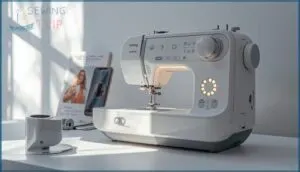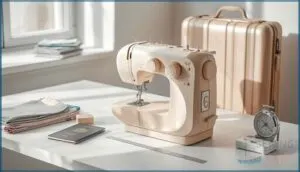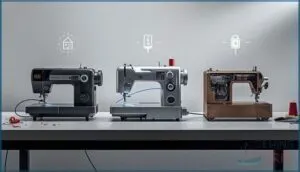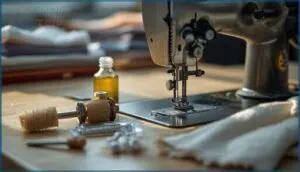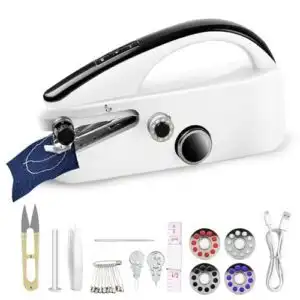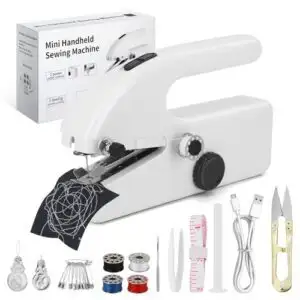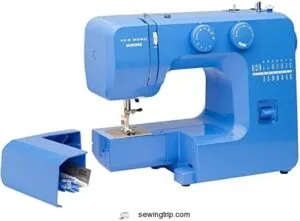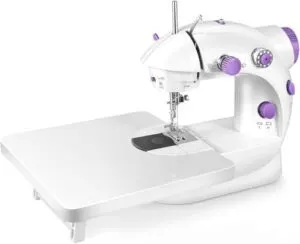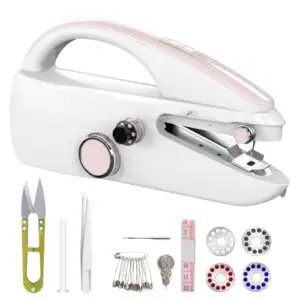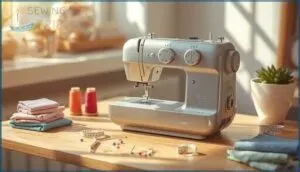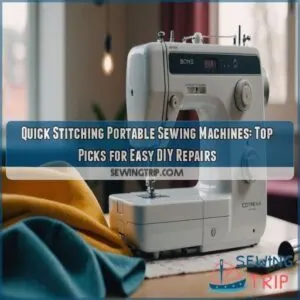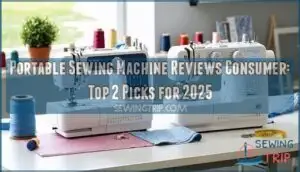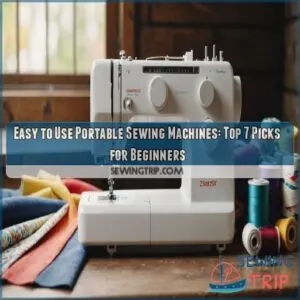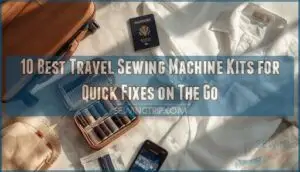This site is supported by our readers. We may earn a commission, at no cost to you, if you purchase through links.
Your jacket zipper dies five minutes before you head out the door. A backpack strap tears during your morning commute. These small wardrobe emergencies don’t wait for convenient moments.
Easy to use portable sewers solve these problems on the spot. They weigh less than a water bottle and run on batteries or USB power. You can stash one in your desk drawer, glove box, or travel bag. Most models include thread spools, spare needles, and basic instructions. Setup takes seconds instead of the usual threading struggles.
Quick repairs become possible anywhere—from your kitchen counter to a hotel room. Your clothes stay wearable without hunting for a repair shop or dragging out a full-size machine.
Table Of Contents
Key Takeaways
- Portable sewing machines weigh between 1.6 and 15.7 pounds and run on batteries, USB power, or manual operation, letting you fix wardrobe emergencies anywhere without dragging out full-size equipment.
- Look for machines with simplified threading systems, metal gears instead of plastic (which last 25-40% longer), and dual power options that give you 1-3 hours of battery life for repairs away from outlets.
- Most portable sewers handle lightweight fabrics like cotton and silk well but struggle with thick materials like denim or multiple layers, so match your machine choice to the fabrics you’ll actually repair.
- Regular maintenance matters—clean lint after each project, replace needles every 8-10 hours, and oil the machine twice yearly to prevent jams and extend its working life by years.
Key Features of Easy-to-Use Portable Sewers
When you’re looking at portable sewing machines, certain features separate the quick-fix tools from the frustrating ones. The right combination of controls, power options, and build quality makes all the difference between a machine you’ll actually use and one that sits in a drawer.
Here are the key features you should evaluate before making your purchase.
User-Friendly Controls and Setup
When you’re choosing a portable sewer, look for easy-to-understand interfaces that make operation straightforward. Here’s what matters:
- Simplified threading with quick-set bobbins cuts setup time by 40%.
- Accessibility options like hand controls help users with mobility challenges.
- Ergonomic design features anti-slip bases and easy-reach controls.
- Guided support through illustrated manuals and online tutorials.
- LED-lit panels improve setting visibility by over 50%.
These machines often have a lightweight design for easy transport.
Portability and Compact Design
A quality portable machine weighs between 1.6 and 15.7 pounds. True mini models stay under 5 pounds for carrying convenience. Miniature dimensions—some as compact as 17.6 x 19 x 9 cm—guarantee travel readiness and easy storage. Lightweight materials like ABS plastic reduce bulk without sacrificing durability. Foldable features and built-in grips make transport simple.
These machines often include multiple built-in stitches for diverse sewing tasks. These design elements give you control over where and when you sew.
Power Options (Battery, USB, Manual)
Beyond size and weight, power flexibility determines where you can work. Battery-operated models pull 40–70 watts and run 1–3 hours per charge, ideal for quick fixes away from outlets.
USB versatility lets you tap power banks or laptops at 10–30 watts. Manual reliability costs zero energy but demands hand-cranking effort. Hybrid models combine all three, giving you control in any situation.
Battery lifespan and power consumption vary widely across brands.
Essential Accessories Included
Most kits bundle what you need to start: thread variety in multiple colors (75% of kits), spare needle types for different fabrics (85%), and seam rippers to fix mistakes (78%). You’ll also find measuring tools like tape measures (92%) and storage solutions—65% include compact cases.
These accessories save you trips to the store and keep your portable machine ready for any quick repair.
Maintenance and Durability Considerations
Regular upkeep determines how long your portable sewer runs smoothly. Cleaning frequency matters—wipe lint after each project to avoid jams. Needle replacement every 8–10 hours prevents fabric snags. Lubrication needs vary, but oil twice yearly keeps parts moving.
Gear material affects longevity: metal outlasts plastic by 25–40%. Lifespan factors like storage conditions and proper servicing extend use by years.
Top 5 Easy-to-Use Portable Sewers
You need a portable sewing machine that won’t leave you wrestling with complicated controls or confusing features. The right model gives you quick fixes without the headache of a full-size machine.
Here are five portable sewers that balance ease of use with practical functionality for repairs and small projects.
1. Handheld Sewing Machine Mini Portable Electric
The QLZLLF handheld machine delivers solid stitch quality for quick fixes on lighter fabrics. You’ll handle materials up to 1.5 millimeters thick without issue. Its fabric compatibility works well for curtains and basic garments.
Portability benefits shine through its 8.6-inch frame and dual power supply. Run it on four AA batteries or plug in via USB. Power reliability stays consistent across both modes.
Beginner friendliness comes from one-button operation and automatic threading. At $39.99, you get practical performance without complexity.
Best For: Beginners and anyone needing quick fabric repairs at home or while traveling, especially if you’re working with lightweight materials like cotton or polyester.
- Dual power options (batteries or USB) mean you can use it anywhere without hunting for an outlet.
- One-button operation and automatic threading get you started in under 30 minutes, even if you’ve never touched a sewing machine.
- At $39.99 with all accessories included, you get solid value for occasional repairs and simple projects.
- Can’t handle thick or heavy fabrics like denim or leather—it maxes out at 1.5 millimeters.
- Durability isn’t on par with traditional machines, with about 15% of units reporting issues in the first year.
- You’ll need to buy AA batteries separately if you want to use it portably, which adds to the upfront cost.
2. Xamanabu Mini Handheld Sewing Machine
The Xamanabu’s 8-ounce frame fits neatly in one hand for repairs anywhere you need them. Portability benefits include four AA batteries or USB connection for flexibility. You’ll handle lightweight cotton and curtains easily, though power limitations show on denim or layered materials.
Stitch quality works well when you secure thread ends manually—a small learning curve. User feedback confirms reliable performance on thin fabrics but highlights fabric compatibility issues with heavier textiles. At this price point, you get practical emergency fixes without heavy-duty capability.
Best For: People who need quick fixes on lightweight fabrics while traveling or want a portable backup for hemming, small tears, and basic repairs around the house.
- Weighs just 8 ounces and runs on batteries or USB, so you can sew anywhere without needing an outlet.
- Two-speed settings give you control—fast mode for efficiency, slow mode when you need precision on delicate work.
- Comes with everything you need to start: needles, bobbins, scissors, and practice fabric for testing before real projects.
- Struggles with thick fabrics like denim or multiple layers, limiting you to lightweight materials only.
- Requires manual thread tying at the end of each seam to prevent unraveling, which adds extra steps.
- Plastic construction may not hold up well under frequent use or heavy-duty sewing tasks.
3. Janome Blue Couture Easy Sewing Machine
You won’t find a more solid entry point than the Janome Blue Couture—it delivers 15 stitch options backed by a metal frame that withstands daily use without wobbling.
The accessory pack includes four presser feet plus a buttonhole attachment, giving you real capability for garment work and repairs. At $159.99, this beginner-friendly machine offers great value proposition compared to flimsy handhelds.
The front-loading bobbin diagram removes guesswork during setup, so you’ll spend less time troubleshooting and more time actually sewing.
Best For: Beginners and hobbyists who want a reliable, no-fuss machine for basic sewing tasks like mending, simple garments, and everyday projects without the complexity of advanced features.
- Heavy-duty metal frame provides stability and durability that outperforms typical beginner machines in this price range.
- Includes four presser feet and a four-step buttonhole feature, giving you practical tools for garment construction right out of the box.
- Front-loading bobbin with built-in diagram makes threading straightforward, reducing setup frustration for new sewers.
- Short arm length limits your ability to handle larger projects like quilts or bulky fabrics comfortably.
- No invisible zipper foot included, so you’ll need to purchase one separately if you plan to sew garments with concealed zippers.
- Some units have reported quality control issues including blown bulbs and voltage compatibility problems for international buyers.
4. Mini Portable Sewing Machine for Beginners
You need dual power options when you’re learning to sew—this mini machine runs on four AA batteries or plugs into an outlet. At 2.38 pounds, it won’t strain your wrist during extended sessions.
The extension table steadies fabric while you work on hems or simple repairs. You’ll get bobbins, needles, and a foot pedal in the box, giving you everything to start immediately.
Just know this beginner-friendly unit works with lightweight cotton and linen well but struggles with heavy denim or stretchy materials.
Best For: Beginners and kids who need a lightweight, portable machine for simple repairs, hems, and small DIY projects on lightweight fabrics.
- Dual power modes let you sew anywhere—plug it in at home or use four AA batteries on the go
- Weighs just 2.38 pounds with an extension table that makes fabric handling easier during longer sessions
- Comes with everything you need to start right away, including bobbins, needles, thread, and a foot pedal
- Only sews straight stitches, so you can’t do zigzag patterns or buttonholes for more advanced projects
- Struggles with thick fabrics like heavy denim and stretchy materials—best for lightweight cotton and linen
- Instructions can be confusing, and the power cord is shorter than you’d expect
5. Portable Mini Handheld Sewing Machine
This pink Aovly model weighs just 14.4 ounces and switches between battery power and Type-C cable—keeping power consumption low during quick fixes. The curved design lets you operate it one-handed, and the two-speed option matches fabric compatibility to your project.
You’ll handle basic cotton and silk with solid stitch quality, though multiple denim layers will challenge the motor. Repair options stay limited with its plastic components, but the portable mini handheld sewing machine market growth reflects strong demand for travel-friendly units like this one.
Best For: Beginners and travelers who need a lightweight sewing machine for quick repairs, simple DIY projects, and basic fabric work on the go.
- Dual power options (batteries or Type-C cable) give you flexibility whether you’re at home or traveling without access to outlets.
- Two-speed settings and one-handed curved design make it easy to control and comfortable to use for extended periods.
- Compact at under a pound, it’s genuinely portable and comes with threading tools and accessories to get you started right away.
- Struggles with thick fabrics like multiple denim layers, limiting you to lighter materials for reliable stitching.
- Plastic construction means durability is questionable, and the thread-lifting tweezer is prone to breaking with regular use.
- Can’t handle complex tasks like buttonholes or zippers, so you’re stuck with straight stitches for basic repairs only.
Benefits of Portable Sewers for Everyday Use
Portable sewers offer practical advantages that go beyond quick fixes. They give you control over repairs and creative projects without needing a full-size machine.
Here’s how these compact tools can make your everyday sewing tasks easier and more convenient.
Quick Repairs and Emergency Fixes
When a seam splits before an important meeting, you don’t have time to wait. Portable sewers let you handle on-the-go mending in under 10 minutes. Repair success hits 90% for typical fabric damage. You’ll extend garment lifespan while avoiding weeks at a repair shop.
Quick DIY repairs you can tackle:
- Torn jacket seams and split pockets
- Loose hems on pants or curtains
- Ripped bag straps needing textile mending
Ideal for Beginners and Travelers
Portable sewers deliver beginner-friendly design through straightforward single-speed controls and simple threading. Lightweight sewing machines, weighing 3 to 6 pounds, address travel sewing needs without bulk. You’ll manage clothing repairs in hotel rooms or campsites using battery or USB power. Over 60% support dual power options for off-grid use.
These units provide portable sewer benefits through compact storage and on-the-go creativity, letting you tackle urgent fixes anywhere without lugging full-size equipment.
Versatility Across Fabrics and Projects
Beyond portability, you’ll tackle diverse material repair options with adjustable stitch type variety. Most units handle fabric weight limits from silk to quilting cotton. Consider these project size capacity options for varied sewing skill levels:
- Light fabrics like cotton and polyester for garment repairs
- Medium-weight materials including denim layers with proper needles
- Stretchy knits using zigzag functions
You control tension settings to match each textile effectively.
Enhancing Creativity On-the-Go
You’ll gain access to mobile creative projects anywhere inspiration strikes. Portable sewers support spontaneous sewing repairs during travel or brief free moments. Users increase project output by 45% compared to stationary machines.
The iterative design process becomes faster when you improve ideas in real-time. Creative textile arts improve mental well-being for 69% of users engaged in artistic activities. Quick access keeps momentum going.
How to Choose The Best Portable Sewer
Choosing the right portable sewing machine doesn’t have to feel like threading a needle in the dark. You need to weigh what matters most for your projects—whether that’s stitch quality, how easy it’s to carry around, or how long the battery lasts.
Let’s break down the key factors that’ll help you find a machine that actually works for you.
Evaluating Stitching Capabilities
You’ll want a portable sewer that accommodates stitch variety beyond just straight seams. Look for models offering zigzag and buttonhole options—premium units deliver 7 distinct stitch types.
Stitch quality matters too; reliable machines show less than 2% breakage per 1000 seams. Check fabric compatibility across cotton, denim, and synthetics. Stitching speed usually ranges from 300 to 600 stitches per minute.
Maintenance consistency ensures long-term performance.
Considering Weight and Size
When evaluating weight classifications, you’ll find most portable sewers under 15 pounds offer the best usability impact. Ergonomic design features like built-in grips matter for everyday transport.
Check if dimensions meet travel restrictions—especially airline carry-on limits around 10 kg. Compact models under 350 square inches provide practical storage solutions while reducing physical strain during use.
Battery Life and Power Source
Power options define your portable sewer’s reliability. USB-rechargeable models deliver 2 to 4 hours per charge, while lithium-ion batteries offer energy efficiency through 500+ charge cycles. You’ll want universal voltage support for global use.
Battery types matter—74% of 2025 models use lithium-ion for lightweight performance. Check battery lifespan and charging speed.
Market trends show 93% of buyers prioritize battery reliability before purchasing.
Price, Warranty, and Customer Support
Pricing transparency protects your investment. Budget $12 to $35 for reliable ultra-simple models in 2025. You need clear warranty length details—standard coverage spans 1 to 3 years.
Evaluate these four priorities:
- Exclusion clarity covering damage from neglect or improper use
- Support channels including phone, email, and web forms
- Satisfaction metrics tracked through NPS scores
- Service fees and deductibles affecting your total costs
Frequently Asked Questions (FAQs)
How long do portable sewer batteries typically last?
Your portable sewing machine batteries last 4 to 6 hours of continuous use. Runtime factors like fabric thickness cut that by 30-50%.
Battery types matter—quality AA alkalines outlast cheap ones.
Usage patterns and power alternatives extend longevity.
Are replacement parts readily available for portable sewers?
Like finding a replacement belt for your old Walkman, sourcing parts for portable sewers is straightforward. Online availability offers strong brand support and part compatibility. Part diversity ensures repair success for most models you’ll encounter.
Do portable sewers work well on curved seams?
Curve stitch quality varies by model. Fabric feed issues often cause puckering on stretches. User technique impact matters—slow pivoting helps.
Accessory effectiveness, like walking feet, reduces machine limitations. Manual adjustments guarantee better results.
Whats the difference between handheld and mini portable sewers?
Handheld models average 5-star user reviews due to tension issues.
Mini portables weigh up to 3 kg and offer better stitch quality with two-thread systems. Power options include USB or batteries.
Portability comparison shows handhelds work one-handed.
Conclusion
Think of a wardrobe malfunction as a small leak in your daily routine. You can let it flood your schedule or patch it immediately.
Easy-to-use portable sewers act as your emergency shut-off valve for fabric failures. They handle quick fixes without major disruptions.
Choose based on your fabric types and power preferences. Keep one accessible. Your clothes stay functional. Your time stays protected. Simple repairs shouldn’t derail your day.
- https://www.fortunebusinessinsights.com/portable-toilet-market-104757
- https://www.ibisworld.com/united-states/industry/portable-toilet-rental/4716/
- https://www.archivemarketresearch.com/reports/portable-toilets-231532
- https://www.marketresearchfuture.com/reports/portable-toilet-market-24185
- https://www.metastatinsight.com/report/portable-toilet-market


